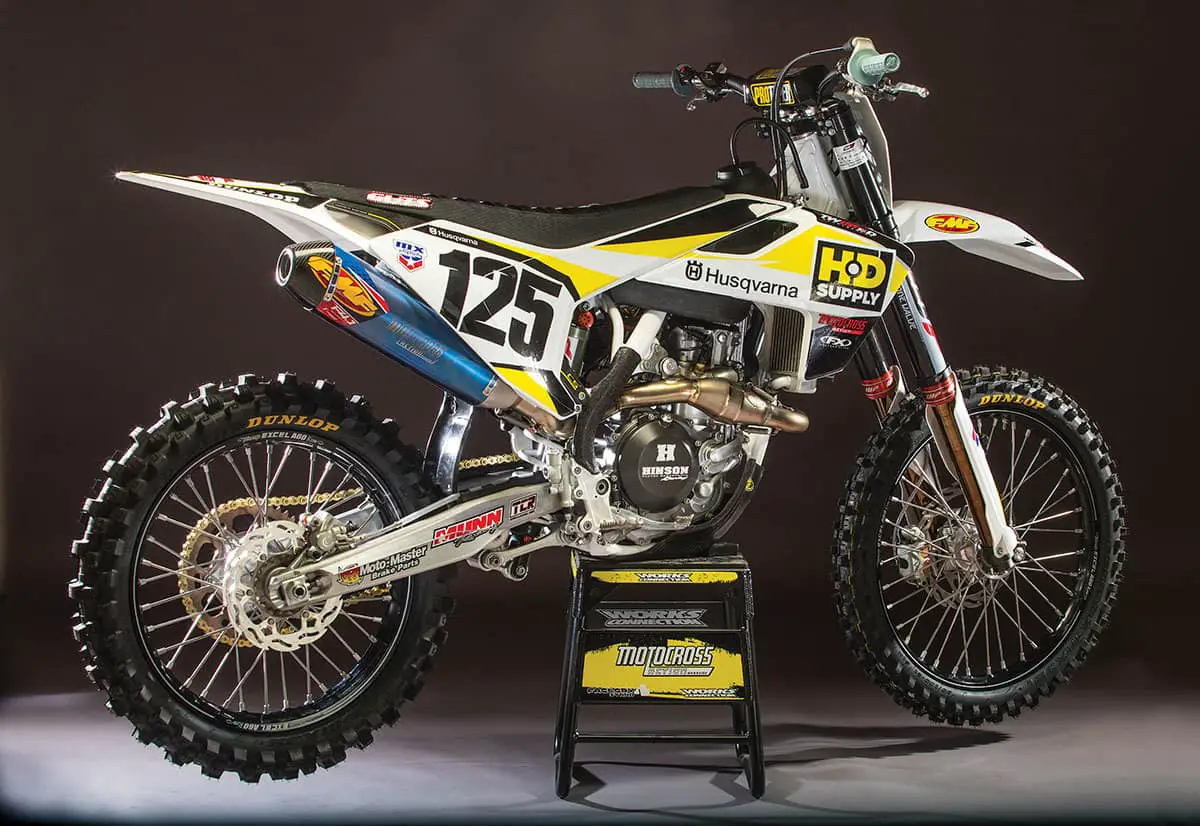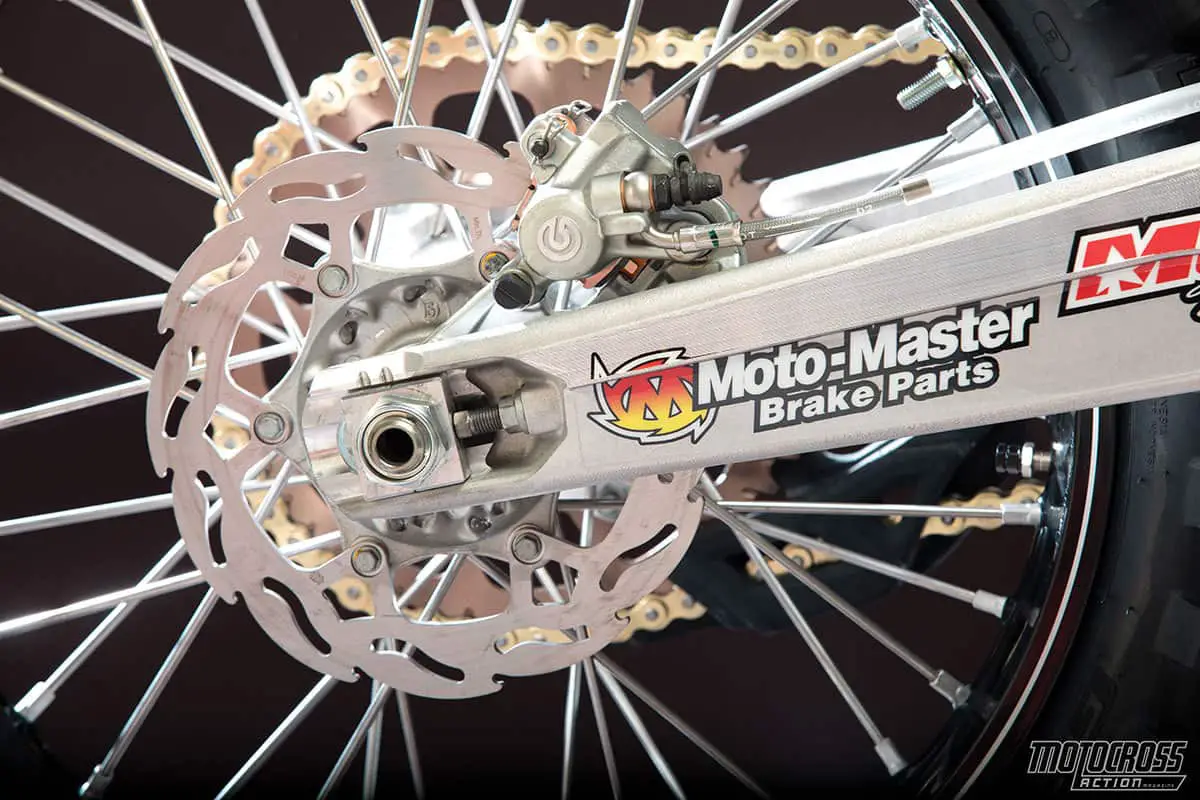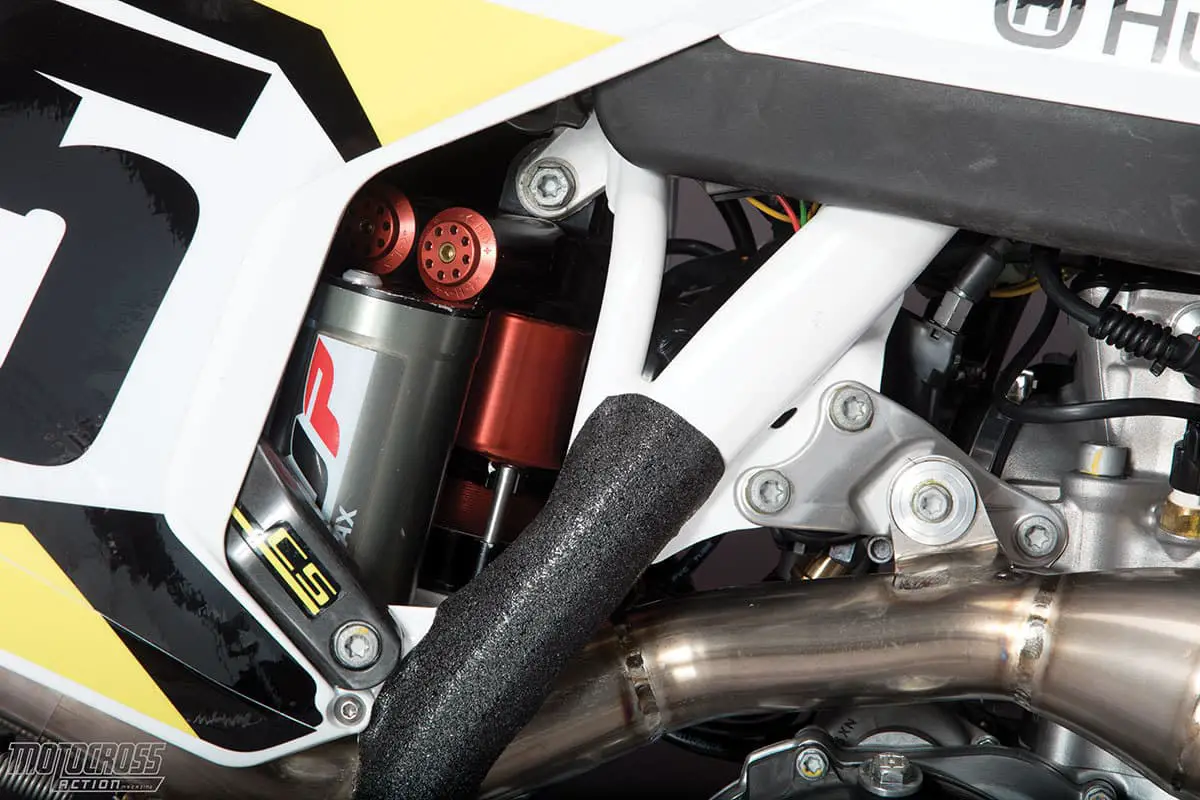WE RIDE JOSH MOSIMAN’S “SMART” HUSQVARNA FC450

This MXA bike test is of interest to the MXA wrecking crew because since we did this test on AMA National rider Josh Mosiman’s Husqvarna FC450 four-stroke, several things have happened.
First, Josh raced this bike in the 2017 AMA 450 Nationals and scored points at ten out of twelve rounds.
Second, Josh used this bike to earn AMA National number 71 for the 2018 season.
Third, unfortunately, Josh crashed at the 2018 Glen Helen National and had to take the rest of the 2018 season off for surgery and rehabilitation.
Fourth, once Josh Mosiman recovered and started getting ready for the 2019 AMA season, MXA offered Josh Mosiman a chance to become a full-time MXA test rider—a gig that would pay him to race motorcycles no matter how well he did.
Fifth, Among the things that got Josh the opportunity to join the MXA staff was the 2017 bike test you are reading now.
Sixth, the man who built Josh Mosiman’s FC450 also joined MXA, where he writes a monthly “Twisted Logic” tech feature.
Why did this test leave such an impression on the MXA wrecking crew? Because it differed in so many ways from a normal National bike test. It was built by an electronic control unit (ECU) genius and had features that were never tried before. Thus, we wanted to bring Josh Mosiman’s Husqvarna FC450 back to give you a glimpse of where the future might be headed.
ASK YOURSELF, WHAT IS THE BEST STRATEGY FOR WINNING RACES? WHAT COMES TO MIND? GET OUT FRONT EARLY. SEPARATE YOURSELF FROM THE PACK, THEN PUT IT ON CRUISE CONTROL. SOUNDS LIKE A GOOD PLAN, RIGHT?
Ask yourself, what is the best strategy for winning races? We admit, it is a vague question. The variables are endless, but what comes to mind? Get out front from the start. Separate yourself from the pack, then put it on cruise control. Sounds like a good plan, right? Well, what if we told you there is a “smart bike” that can control these situations for you? A bike that will get off the gate without breaking traction, and when you hit the afterburners, it will launch you into the first corner. Then, once you’re up front, the powerband will settle into a nice, smooth power delivery without you doing a thing. Okay, maybe we are a few years away from autopilot, but “smart-bikes,” just like smart-cars and smartphones, are going to be our sport’s future. That is, unless the AMA were to put its foot down. But, who are we kidding? The AMA put its foot down? Luckily, we know the guy who is at the forefront of the next generation of dirt bikes and he can give us a glimpse of what’s in store.

Jamie Ellis from Twisted Development is no stranger to the MXA wrecking crew or the motorcycle industry. He has paid his dues on the front lines of the sport. He has been the go-to guy for engines for privateer teams and riders—engines that are capable of running at the factory level. He is a master of his craft and one of the leading proponents of ECU development. The ECU is the brain of the bike and, unlike home-schooled Amateurs, its IQ keeps going up each year. Jamie’s weapon of choice is the Australian Vortex ignition. He has a hand in developing ideas and concepts with the company.
THE FLY IN THE OINTMENT? ANYONE CAN BUILD AN ENGINE FOR THE START, BUT WHAT ABOUT THE REST OF THE TRACK?
 We love the pucker power of the stock FC450 brakes, but love the Moto-Master rotors even more.
We love the pucker power of the stock FC450 brakes, but love the Moto-Master rotors even more.
One of Jamie’s privateer riders, Josh Mosiman, needed a game plan for the 2017 AMA 450 Nationals. Josh has a few Amateur titles under his belt and raced the entire AMA 250 National series in 2016 (making the 40-man gate at each and every round). In 2017, Josh is racing the 450 class. He knows that to get the results he wants, he needs to get up front early. It is just about impossible to make up ground from the back of the pack in such a stacked field. That means he needs power and lots of it to pull to the front of the pack in the deep loam of the long outdoor National starts. The fly in the ointment? Anyone can build an engine for the start, but what about the rest of the track?
Jamie Ellis and Josh Mosiman collaborated on a strategy for the 2017 AMA Nationals. Get up front early. Pin it for the first few laps, then settle into a smooth groove. Sounds easy, but executing this plan against the best and most experienced riders in the world is a big undertaking. Jamie wanted to make it as simple as possible for the young rider. He felt he could accomplish this with a powerful engine managed by the ECU.
 This is a “no excuses” engine that pumps out 65 horsepower. You want to start out front? This is the engine for you.
This is a “no excuses” engine that pumps out 65 horsepower. You want to start out front? This is the engine for you.
The first piece of the puzzle was building a bike that was too fast for any rider to hold on to during a 30-minute-plus-2-lap moto. Josh’s sponsors, HD Supply and Scrub Blade, bought a Husqvarna FC450 for Jamie to transform. The FC450 is a great platform to start with, as it pumps out 57.14 horsepower (on our dyno) in stock trim. The multifunction handlebar map switch that comes standard on the FC450 is the perfect control panel for Jamie’s ECU brain. Jamie knows the pony numbers of the factory bikes are somewhere in the realm of 63 horsepower.
To get Josh ahead of these high-powered engines off the start, he needed to go above and beyond that while still keeping reliability in mind. Josh’s new Jamie Ellis engine pumps out 65 horsepower on his dyno (he got 55 horsepower on his dyno with the stock engine). He said he could increase horsepower even more, but the 20-hour maintenance intervals would drop significantly, and the engine wouldn’t be as reliable for the rugged outdoors.

To attain this high-horsepower number, the crankshaft was balanced by drilling a hole in the crank, and then tungsten was welded on (the same tungsten that is used on men’s wedding rings). Tungsten was used because of its high density (it is heavier than steel). The actual amount was determined by the piston. This is achieved by rolling the weight of the piston over an inertia machine and then adding the appropriate weight so that when the piston is moving up and down, no counterbalance is needed, it makes for a smoother-running engine. This process also decreases vibration, allows the engine to rev faster and increases the response of the engine (thanks to the true crankshaft).
Jamie designed a special piston that JE Pistons made for him. All the cylinder head porting is done in-house. Jamie told us a lot of his power gains come from how efficiently he gets air and fuel to flow through the 400-thousandths-of-an-inch gap between the valve seats. Jamie estimates 80 to 85 percent of the power he produces comes from the piston up. The remaining 15 to 20 percent comes from the piston down, where he makes the engine run freer with crank balancing and WPC treatments on the engine internals (like the transmission).
 Jamie Ellis from Twisted Development balanced the crank, ported the head, modified the valve seats and WPC-treated many internals.
Jamie Ellis from Twisted Development balanced the crank, ported the head, modified the valve seats and WPC-treated many internals.
Let’s skip ahead a bit to give you a taste of what 65 raw horsepower felt like at full tilt. Jamie put the brain of the bike in hibernation mode so the MXA test riders could experience the raw output of power. The bike was almost unrideable. The response of the bike was too fast for our Pro test rider’s reactions. That is usually not a problem with responsive engines, but when you have a bike with immense power, it gets away from you easily. This was most noticeable on the downside of jumps when we landed just a bit short and hit the throttle before we bounced off the landing. Just a small blip of the throttle almost looped the bike off the landings. Up Glen Helen’s big hills, it either spun the rear or wheelied (both issues forced us to chop the power), but once momentum was established, we could click up a gear higher and get mastery over the power. It reminded us of what a fighter pilot must go through when jet thrust kicks him back in the seat on take-off. Thankfully, once at speed, the ride smooths out.
SEEKING THE PERFECT START

There are a lot of factors involved in getting a good jump off the gate. Clutch feel, throttle position, body and feet position, reaction time, listening to the engine rpm, and managing the front brake all at once can be tough. A combination of too much throttle and dumping the clutch will either loop you out or cost too much traction at the rear wheel. Doing the opposite will leave you in the dust. Jamie makes the dynamics of the start simpler by teaching the “brain” what to do.
Jamie can set the max rpm of an engine to whatever he wants. On Josh Mosiman’s Husky, he set the cap for 10,000 rpm. This made metering the throttle dummy-proof. For outdoors, a rider usually needs full power out of the gate. For Supercross, due to the high traction on the dirt and then the slick surface of going over the gate, Jamie actually detunes the engine. Now the rider can dump the clutch and hold the throttle wide open and he will get off the gate the same each and every time—as long as his body positioning remains consistent. Once the clutch is fully disengaged, a load is then put on the engine, which drops the rpm below 10,000 rpm. This drop in rpm disables the rev limiter and starts a timer that Jamie programs in.
 The full FMF exhaust system on the FC450 was tailored to work with the Twisted Development powerhouse.
The full FMF exhaust system on the FC450 was tailored to work with the Twisted Development powerhouse.
Timer? What timer? In the Vortex ECU (the brain of the bike), a timer can be set to 999 seconds when the 10,000-rpm trigger is hit. This 16 minutes and change allows Jamie to put whatever custom map he wants in before it switches over to the next map of his or the rider’s choosing. To implement his strategy, Jamie installs a map that pumps out full power without all the rough edges we experienced earlier when the power was in its raw form. This full-power tactic will out-power the other bikes, allowing Josh to get towards the front of the pack early in the moto when a rider has the best chance to make multiple passes—while the pack is still tight. The added power allows Josh to get out off the main line and into the deep loam to make these potential passes. There is no way Josh, or anyone else for that matter, could handle the power while riding at 100 percent for the whole race, so the timer is set to end around the 5-minute mark.
PUTTING ITSELF IN CRUISE CONTROL
 The future of “smart bikes” is here. Twisted Development tells the brain of your bike what to do when you want it to.
The future of “smart bikes” is here. Twisted Development tells the brain of your bike what to do when you want it to.
The last part of the Ellis plan allows Josh to get in a smooth groove and ride flawlessly. Smooth, effortless and fast power is the key to the plan. It sounds easy, right? Our test riders helped Jamie in the development of this map. There are two different areas that can be altered by the ECU map—ignition timing and fuel mixture. Jamie can retard or advance the timing and lean or richen the fuel mixture throughout the entire powerband with an almost infinite number of possible combinations. Our starter map, for instance, had a sluggish feel off the bottom, forcing us to downshift into the corners and use the clutch more. After that, the power spiked and was hard to control. After we told Jamie what we felt, he leaned out the fuel mixture and advanced the ignition timing off the bottom at 5- to 15-percent throttle and did the opposite at 15- to 45-percent throttle to detune the power and make the FC450 easier to ride. Initially, it was too snappy off the bottom for our test riders, but the transition to the upper half of the power was much more linear. To smooth out the transitions, Jamie produced an easier-to-ride map on the spot. It was still incredibility fast, but it was so linear that it gave us the impression we were going much slower than we actually were. The bike stuck to the ground like glue without making the front end feel too light. This was the map we liked best for settling in for the long haul.
THE SMART-BIKE STRATEGY
 The WP Cone Valve forks have a supple feel with great bottoming resistance. They are worth their weight in gold.
The WP Cone Valve forks have a supple feel with great bottoming resistance. They are worth their weight in gold.
What do we think of the smart-bike strategy? In theory, it sounds like the next stage in the evolution of engine management. It gives the rider fewer things to think about and endless tuning possibilities. The question is, do we want to follow in the footsteps of MotoGP road race technology where Valentino Rossi believes that electronics have lessened the importance of talent? Will future winners be determined by how good the bike is rather than how good the rider is? Bike performance has always been a factor in results, but with high-tech electronics, the percentage is increasing on the tech side of the ledger. Still, tech wars have a way of evening out—and all the great riders will eventually have the same whiz-bang, computer-aided machinery. As for the lowly privateer; for him, bikes will become more expensive. How expensive? The cost of Jamie Ellis’ engine package and ECU settings ran around $6500. The good news? That money will put your bike on par with any factory bike that you line up next to. The bad news? Without this level of electronic trickery, you will be left in the dust.
 We have absolutely fallen in love with the WP Cone Valve forks and shock. This is what real suspension is all about.
We have absolutely fallen in love with the WP Cone Valve forks and shock. This is what real suspension is all about.
It is awesome that a company like Twisted Development exists, and for now, they are fighting the good fight to close the gap on the factory works bikes. Best of all, they offer their technology for sale—and don’t hide it away like the works teams. You can learn more about Twisted Development at www.td-racing.com.
TWISTED DEVELOPMENT FC450 SUPPLIERS
www.td-racing.com
www.jepistons.com
www.fmfracing.com
www.vortexcdi.com
www.wpnorthamerica.com
www.tcrwheellacing.com
www.dunlopmotorcycletires.com
www.factoryeffex.com
www.protaper.com
www.motomaster.com
www.acerbis.com
www.scrubblade.com
www.hdsupply.com






Comments are closed.